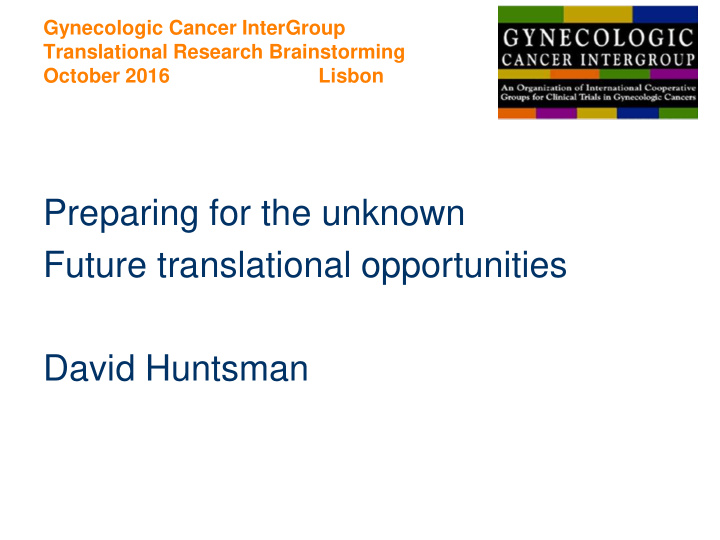



Gynecologic Cancer InterGroup Translational Research Brainstorming October 2016 Lisbon Preparing for the unknown Future translational opportunities David Huntsman
COI – disclaimer • Relationships with commercial entities – Contextual Genomics – founder and CMO – Research support received from - Sanofi, Pfizer, Takeda, Novartis, GSK • COI-Mitigating strategies – Generic drug names only used – No products or other work from Contextual Genomics to be discussed
Gynecologic Cancer InterGroup Translational Research Brainstorming October 2016 Lisbon Outline The last five years- major translational research opportunites, what is required and what can be learned Tissue based proteomics to support translational research Biobanking for tomorrows opportunities: is this too much to ask?
New opportunities NGS - last five years • Target gene • First required frozen now resequencing for FFPE mutations • Whole genome • Still requires frozen tissue sequencing for mutations and matched normal for and landscape features optimal analysis • Analysis of intra-tumoral • Requires frozen tumor heterogeneity – WGS and but some analysis can be single cell analysis done from FFPE+/- plasma
NGS – aligned technologies • Epigenomic profiling • Targeted epigenetic analysis (methyl seq and CHIPseq can be performed on FFPE, etc) full profiling requires frozen tissue • RNA seq protocols for FFPE • Transcriptome analysis exist but require validation, Nanostring and other methods work well for limited analysis
Other opportunities • Cell free DNA analysis • Either specially collected or rapidly processed plasma • Usually performed on • Metabolomics urine • Any reasonable non • Pharmacogenomics tumour source of germline DNA for validation, high quality DNA for discovery work • Direct assessment • HRD assays requires living cells, indirect assessments from FFPE
Lessons learned from recent new opportunities 1-- Some technologies like full gene resequencing get reduced to practice to work on FFPE 2 – Some technologies particularly those which require well preserved dissaggregated or living cells are unlikely to scale 3- Full genome analtsis creates complex and large datasets that can be rendered near-uninterpretable by the predictable artefacts of standard fixation thus best done in frozen material 4- Some opportunites like cell free DNA analysis require new samples types but they are easily obtained without large deviations from normal lab practice
What about proteomics? Proteomics has not been used in many clinical trials as it has not been reduced to practice – frozen samples have been needed and tissue amounts beyond what can be acheived clinically Tissue based CyTOF and other antibody based in-situ mass spec analysis show promise but are labor and time intensive We have proof of principle for full proteome sceening of FFPEC materials (Hughes et al Sci Reports 2016)
CTH 0 = no staining 1 = weak or variable staining 2 = strong, diffuse staining
Cysteine Biosynthetic Pathway Higher in clear cell CTH CBS Methionine Homocysteine Cystathionine Cysteine Glutathione
CTH is Highly Expressed in Clear Cell Ovarian Cancer HGS ENOC CCOC
CTH and CBS Expression in Cell Lines ENOC CCC HGS Kuramochi TOV112D OVCAR 3 OVCAR 4 OVCAR 5 OVMANA OVTOKO OVSAYO TOV21G IGROV1 JHOC5 JHOC7 JHOC9 CaOV3 CaOV3 OVISE A2780 RMG2 2008 Hey Hey CTH CBS a -Tubulin CBS CTH Homocysteine Cystathionine Cysteine
CTH Expression in Normal Tissues Fallopian Tube Endometrium
The Origins of Endometriosis Associated Ovarian Cancer? Cell of Origin for Endometrioid Ovarian Cancer? Cell of Origin for Clear Cell Ovarian Cancer?
Gynecologic Cancer InterGroup Translational Research Brainstorming October 2016 Lisbon INSERT PROGNOSIS SLIDE
Biospecimen collection: local biobank experience A motivated team can have high accrual rates Generic approvals with secondary project specifc applications possible Intensive acivities such as establishing xenografts or collection multiple biopsies (spatial or temporal) possible Success is due to voluntary efforts of mutually interested parties which helps control costs Best source of high quality materials but not expandable without great expense
Biospecimen collection: National and International collections Very expensive to establish biobanks in sites where there is no interest in translational research – such top down efforts are unlikely to be flexible enough to rapidly embrace new opportunites such as cell free DNA collection Extensive collections of QA’d frozen or FFPE material can be aggregated from pre-existing collections (OTTA and TFRI Couer) – approach not that useful for trials
Biospecimen collection for undeclared needs It would seem reasonable that appropriate consent and banking FFPE tumour, Normal DNA from cheek swab of blood, and even collection of samples for cell free DNA analysis should be possible in all sites engaged in modern clincial trials – such materials will be useful for most common translational needs Other more demanding but useful collections such as living or fresh frozen materials or biosies from multiple time points on study could be collected by leading research sites within studies and perhaps used for hypothesis generating experiements with validation (post reduction to practice) performed on samples from the rest of the study Note: full scale proteomics is possible from FFPE with IHC providing a natural validation strategy
Recommend
More recommend